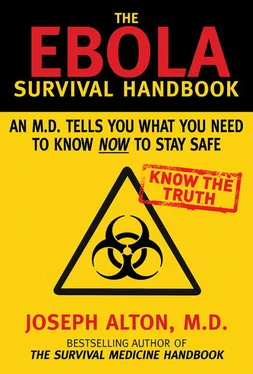TIP
Remember that Ebola is not just contagious from being in contact with a living victim; it remains contagious even after the victim has died.
So, as time goes on, the situation worsens. It hasn’t helped that the global community is coming in a day late and a dollar short. A condition that was once contained in the farthest reaches of the world has decimated several African countries’ populations and economies and made its way to Europe and the United States.
FROM ANIMALS TO HUMANS
Ebola is not the only malady known to derive from interspecies contact. Scientists have estimated that six to ten of all infectious diseases in humans are spread from animals. Whether from a bite or other contact, humans have contracted a number of serious diseases from animals.
| Bubonic Plague |
Also known as the “Black Death,” the Bubonic plague took down more than a quarter of the population of Europe and Asia in the fourteenth century. The bacterial disease has symptoms including fever, chills, weakness, and swollen and painful lymph nodes, and is carried by fleas on rodents and sometimes cats. |
| Chagas Disease |
A frequently fatal infection transmitted by the feces of blood-feeding bugs called triatomines, which may live on dogs, chickens, or other domesticated animals. |
| HIV |
HIV, short for human immunodeficiency, is the virus that causes AIDS. It kills by destroying the human immune system and has been traced back a century from contact with chimps and other primates. HIV was first documented in the United States in 1981. |
| Hantavirus |
Hantavirus, carried mostly by deer mice, is contracted by breathing in dust contaminated with mouse droppings. Symptoms include a stiff neck, fever, and confusion. It’s incurable but is generally not fatal. |
| Malaria |
Spread by mosquitoes and most prominently found in hot, humid climates, malaria infects 350 million or more people every year. |
| Rabies |
While infected dogs are mainly responsible for transmitting this disease by biting humans, many wild animals can carry rabies, including bats. |
| Influenza |
Various types of flu viruses begin with an animal “reservoir.” For example, H1N1 (swine flu) began with pigs, and bird flu started with domesticated poultry. |
| Toxoplasmosis |
The toxoplasma gondii parasite infects about fifty million Americans, and its primary host is house cats. Transmission to humans is through cat feces, which is why pregnant women are warned against changing litter boxes. |
THE SPREAD OF EBOLA
Ebola has been around since 1976, but not as an ongoing condition. While the disease has never been eradicated, outbreaks seem to go into periods of growth and, for want of a better term, “remission.” Sometimes years will go by between outbreaks of the deadly disease, which sparks curiosity about how it continues even when it seems dormant for periods of time.
There are several methods of transmission of the Ebola virus. Here’s how you can and can’t get the virus, at least from our current knowledge.
Ingestion—Eating infected animals, especially if undercooked. This is the most likely way that Ebola began in the human population of West Africa, where infected bats are part of the diet.
You cannot get Ebola, however, from simply eating food at the same table as someone who has it or drinking from a water source in an area that has Ebola patients.
Inhalation—Breathing in droplets of blood splatter, vomit, or saliva of an infected patient. It is unlikely you will get it by simply breathing the same air in the room as someone who has it, although new commentaries from the Center of Infectious Disease Research and Policy (CIDRAP) and the US Army Medical Research Institute of Infectious Diseases (USAMRIID) are casting doubt on this. CIDRAP suggests that previously unexpected smaller viral particles may stay in the air in aerosol form. If this is the case, these particles may stay suspended for more than ninety minutes.
TIP
You cannot get Ebola from simply eating food at the same table as someone who has it or drinking from a water source in an area that has Ebola patients.
Another argument for airborne transmission comes from a 2012 study in which pigs were infected with Ebola virus in the same room as monkeys (separated by three meters). The monkeys contracted the virus without any known contact with the pigs.
The question of whether Ebola is “airborne” may be a matter of semantics. You could get Ebola if, for example, blood splatter is flung into the air and lands in your eye or nose. Certainly, this can be considered “airborne,” but a better term would be “aerosol transmissible,” in this case, with blood droplets.
Injection—Handling contaminated needles, syringes, or other medical supplies used on an infected individual. “Injection” could possibly include a bite from an animal carrying the Ebola virus. Dogs can be infected with Ebola without any noticeable effects but might be able to pass the virus to a human they bite. In fact, it is thought that 9–25 percent of all dogs in the epidemic zone carry the antibody for the virus. This means that there is evidence that they were, at one point, infected.
Absorption—Touching secretions from an infected individual and then touching your mouth or an open sore.
Sexual transmission—Ebola can be transmitted through sexual contact with someone who is infected. Interestingly, the semen of an infected individual is contagious for up to two months even if they have recovered from the illness.
Pregnancy—The virus may be passed from mother to fetus, even during breastfeeding.
Complacency—Complacency in our attitude toward infection control precautions may be the ultimate downfall when it comes to transmission of Ebola. If we do not pay strict attention to hand washing and other hygienic measures, we may pay the price.
Could Ebola mutate to the point that it will become absolutely airborne like influenza? Most experts say no; as so far it hasn’t been the case with any strain of the virus. Also, as there has been so little change in the virus in the past forty years, it’s unlikely that it would suddenly take on new and insidious characteristics.
Ebola spreads easily when the right care isn’t taken in its treatment or when it isn’t diagnosed correctly. When precautions are taken and care employed from the first sign of fever, it is actually fairly simple to contain. This is why it’s important to know right away what health-care workers are dealing with—a painful lesson for us recently in the United States and also in Spain.
TIP
Ebola spreads easily when the right care isn’t taken in its treatment or when it isn’t diagnosed correctly. When precautions are taken and care employed from the first sign of fever, it is actually fairly simple to contain.
EBOLA IN SPAIN
In September 2014, Teresa Romero, an assistant nurse in Madrid, Spain, was infected with the Ebola virus after caring for a Spanish missionary who had been sent home from Liberia with the disease. The missionary (and a second one) succumbed to the illness. Ms. Romero had apparently gone undiagnosed for days, despite that she had: 1) been treating two patients with Ebola, and 2) developed a fever.
Health officials suspect that she may have inadvertently touched her face with a gloved hand—a quick, thoughtless gesture that could have happened to anyone. It was that simple. Human error again plays a part.
Читать дальше



![John Stieber - Against the Odds - Survival on the Russian Front 1944-1945 [2nd Edition]](/books/405234/john-stieber-against-the-odds-survival-on-the-russian-front-1944-1945-2nd-edition-thumb.webp)








